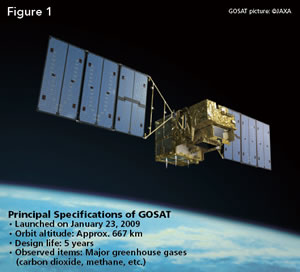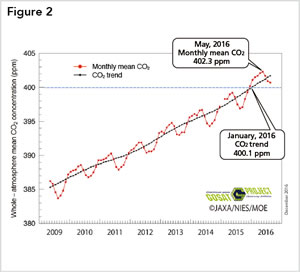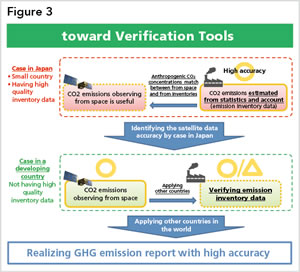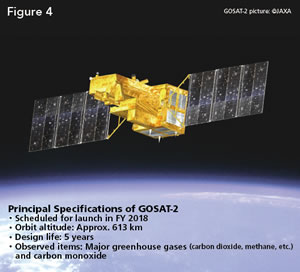Feature
Global Environment Observation by the GOSAT Series
Japan developed and operates GOSAT, the world's first satellite designed specifically to monitor the concentrations of greenhouse gases (GHGs) such as carbon dioxide and methane on a global scale. It shows the possible applicability as a highly-transparent tool for monitoring and verifying the national inventory of GHG emissions that all countries of the world are required to submit based on the framework of "The Paris Agreement". As GOSAT-2 is scheduled to be launched in FY 2018, we are making further contributions to the reduction of GHGs by proactively developing the global environment observation by the GOSAT series.
In recent years, techniques to observe the earth's atmosphere by satellites have been improved dramatically. Japan developed and operates the Greenhouse Gases Observation SATellite (GOSAT), aka "IBUKI", the world's first satellite designed specifically to monitor the concentrations of major greenhouse gases (GHGs) such as carbon dioxide (CO2) and methane (CH4) on a global scale (see Figure 1).
GOSAT was jointly developed by three institutions, Ministry of the Environment (MOE), the National Institute for Environmental Studies (NIES) and the Japan Aerospace Exploration Agency (JAXA). The satellite was launched from Tanegashima Space Center on January 23, 2009 and has been continuously monitoring the global environment. A large amount of data obtained from the satellite has been analyzed in a special way, and has helped to account for various phenomena caused by GHGs.
For instance, a recent analysis of GOSAT observational data has revealed that the whole-atmospheric monthly mean CO2 concentration exceeded 400 ppm (see Figure 2). It has also become clear that the sources of CO2 and methane can be identified by determining whether they are anthropogenic or natural based on their concentration levels in the atmosphere measured by GOSAT. This has opened up the future possibility of the satellite to be applied as a tool for monitoring and verifying the national GHG inventories (see Figure 3).
Meanwhile, the Paris Agreement, an international framework for GHG reduction after 2020, was adopted at the 21st session of the Conference of the Parties to the United Nations Framework Convention on Climate Change (COP21), in December 2015, and went into force on November 4, 2016. More than 120 countries and regions including Japan have ratified the Agreement so far (as of January 2017).
All Parties to the Paris Agreement will be required to regularly report on their GHG emissions and their implementation efforts in a common and flexible manner. These reports will be subject to reviews in which transparent examinations will be essential. Therefore atmospheric observation satellites of various countries such as Japan's GOSAT series and the American OCO-2 satellite, which can observe the whole globe uniformly, are incorporated as monitoring and verification tools for GHG emissions, in addition to ground-based measuring instruments.
GOSAT has already exceeded its design life of 5 years and has been operating for 8 years. In order to continually fulfill its role in the international community, Japan started developing "GOSAT-2," a successor of GOSAT in 2012, and is scheduled for launch in FY 2018 (see Figure 4).
To expansively take over the role of GOSAT which observes GHGs at multiple points all over the world with high accuracy, GOSAT-2 is designed with strengthened functions to find out the behavior of global GHGs with even higher accuracy and density and to enhance accuracy of measurement of gas emissions and sinks by region, such as the function to automatically detect and avoid clouds which interfere with measurement from space and the function to enable measurement of carbon monoxide (CO) concentrations to identify the concentrations of anthropogenic CO2 more accurately.
Through these efforts, MOE is actively developing global environmental monitoring by the GOSAT series and making further contributions to the reduction of GHGs by proactively promoting cooperation and collaboration with other countries.
More Information:







